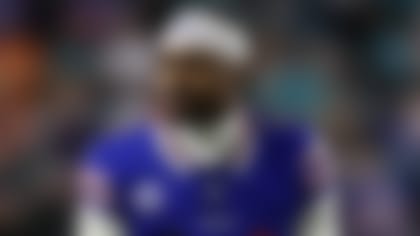Exploiting matchups is key in fantasy and can help us unearth sleepers, value plays and also alert us to when we should fade or lower expectations for more establish studs. There are a number of statistics and data-based tools to helps us decipher which matchups to exploit and which to avoid, and one of which is the NFL's Next Gen Stats package -- not just the fancy speed numbers you see on television.
Here we'll look where cornerbacks and wide receivers line up, which defenses are particularly susceptible to which player packages and so much more in order to find value with our fantasy players. As the season goes along we'll have even more data to use and a better understanding of the Next Gen Stats. Here are the top matchups that could bring value in Week 9.
Jordy Nelson vs. Colts secondary
After much weeping and gnashing of teeth at the thought of Jordy Nelson's diminished rest of season outlook after a one-catch game las Thursday night, the veteran bounced back nicely in Week 8.
The biggest key to his success was Green Bay being flexible with his alignment. With Randall Cobb out of the lineup, the Packers asked Nelson to play a season-high 63 percent of his snaps from the slot. Nelson got free for his biggest play of the season, a 58-yarder that came from when he lined up in the slot:
Nelson has had issues this season separating from outside coverage, ranking 37th out of 41 receivers in yards of separation at target (1.96) among receivers with 30-plus targets outside. He has not been winning contested catches like he once did either, with just a 37.5 percent catch rate when he has less than a yard of separation.
However, Nelson's separation does increase when he moves into the slot. On his 18 targets from the slot Nelson averages 2.26 yards of separation from the nearest defender. That's still not a great score, as it ranks 42nd out of 44 receivers who have 15 or more targets from the slot this year. Yet, at least it is an improvement.
As currently constructed, the Packers need to be a spread offense. They took that approach in Week 8 running four or five wide receivers on 53.3 percent of their plays run against Atlanta. It was no coincidence that the result brought about Aaron Rodgers' best game of the season. Four different Packers receivers caught a touchdown and five caught multiple passes.
If the Packers continue to use this package, it would allow Nelson to play the majority of his snaps from the slot, which might be where he's best suited at this point in his career. A similar move has preserved Larry Fitzgerald's statistical dominance as he ages, and Nelson is at a similar career arc. The Packers best offensive package is likely with four wide receivers and the positioning as follows:
Left wide: Davante Adams
Slot 1: Jordy Neslon
Slot 2: Randall Cobb
Right wide: Janis/Allison/Davis rotation
Backfield: Ty Montgomery
Without a true experienced running back healthy and on the roster, Green Bay could manufacture a type of run game with Montgomery in the backfield as they did in Weeks 6 and 7 in a Theo Riddick-type role. He could also flex out into the slot to give Green Bay five receivers, or alternate with Cobb in the backfield.
Sam Bradford vs. Detroit's front seven
In his first four starts Sam Bradford owned a 104.2 passer rating against the blitz, showing an unprecedented ability to throw from the pocket compared to the rest of his career. In recent weeks, the Vikings offensive line has deteriorated with injuries. They are starting Jake Long at left tackle, who has not been a viable NFL player in about three years. It's likely no coincidence that Bradford's passer rating against the blitz dipped to 54.5 the last two weeks.
One of the reasons for the Lions defensive ineptitude is they have been missing the presence of their best defensive player, pass rusher Ezekiel Ansah. The fourth-year defensive end broke out in a big way with 14.5 sacks in 2015 after two solid years in the NFL. Unfortunately, he suffered an injury after just two snaps in Week 2 and missed multiple games after that. He returned to a part-time role in Weeks 6 and 7, playing just 55 and 56 percent of the snaps. The good news for the Lions is that he may finally be close to all the way back. Ansah played 75 percent of the team snaps in Week 8, which is much more in line with his typical workload (71 percent in Week 1).
Make no mistake, Ansah is a difference-maker when healthy. Even in limited work this season, he's one of the better performers in Next Gen Stats' new pressure metric -- average distance to quarterbacks at the time the ball is passed or when the quarterback is sacked. Ansah's 4.67 average distance ranks 21st in the NFL among defensive ends.
If Ansah comes after Bradford across from Jake Long's side of the line, or even against T.J. Clemmings on the right, the Lions will have a mismatch. This should be Ansah's breakout game for 2016, where he's yet to record a sack. Anyone projecting Bradford for a solid game in Week 9 might want to reconsider knowing this.
Amari Cooper vs. Broncos cornerbacks
Coming off a dominant game against the Tampa Bay Buccaneers in Week 9, Amari Cooper faces a much tougher task in the Denver secondary. Aqib Talib might miss another game but the other Broncos corners are more than capable of limiting top wideouts.
We know that Amari Cooper tends to do most of his damage on the left side of the field. Cooper takes 56 percent of his snaps from wide left, and has over half of his receiving yards on receptions when lined up at that position:
BroncosPro Bowl corner Chris Harris is well-known for his ability to cover both outside and slot receivers, a tougher task than many give it proper credit for. When he is not covering the slot, he's typically playing right corner. Harris lined up pre-snap on the wide right side of the defense 45.4 percent of his snaps this season, the most of any other position.
Harris and Cooper have a history from their meeting last year, the Raiders and Broncos squared off twice in Cooper's rookie season. Harris covered him on seven pass plays in the first contest, Cooper never saw a pass come his way. The second Broncos game was Cooper's worst statiscial outing of his career, where he was held without a catch on eight targets. Harris covered him on six pass plays. Derek Carr sent two passes Cooper's way in that game, neither of which were completed.
The next catch Cooper gets on Chris Harris will be his first. Expect the two to square off for the majority of Cooper's routes on Sunday. The 2015 fourth overall pick has been on fire for much of the season, but the team has been willing to go elsewhere when the matchup with Cooper just isn't there, as evidenced by his outing facing Jalen Ramsey's shadow coverage:
Of course, Cooper is so talented he could still take this secondary over. We'll know a lot more about where Cooper sits on the pantheon of receivers after this game.
Brian Quick vs. Panthers secondary
Brian Quick has been the big play threat for Los Angeles, not his more well-known teammate Tavon Austin. Quick's 14.6 average intended air yards per target on the season is one of the ten highest marks among receivers with 30 or more targets. His differential between intended to completed air yards is also solid with just a 2.67 mark. For context, only Julio Jones, Brandon Marshall, Adam Thielen, A.J. Green and Alshon Jeffery have lower differentials while checking in with an average intended air-yards figure of 13.5.
Quick has also converted in tight spaces, with a 70 percent catch rate when he has less than a yard of separation. With rumors that his time as the starter may be running out as the team prepares to install No. 1 overall pick Jared Goff as the starter, expect Keenum to go down swinging. Always a gun slinger, Keenum ranks second in Next Gen Stats' quarterback aggressiveness metric (percentage of passes thrown when targeting a receiver who has less than one yard of separation from their defender). Keenum has thrown 24.6 percent of his passes in such situations.
Quick totaled season-highs in targets (nine), receiving yards (92) and snap share (71 percent) in the Rams London game before the bye. The Panthers travel to Los Angeles to take on the Rams in Week 9. The Panthers bleed big plays to wide receivers, giving up the second-highest yards per target (9.28) to the position. Quick lines up at right wide receiver on 53 percent of his plays, which should match him up against veteran Robert McClain and burnable rookie Zack Sanchez, who split snaps at left corner for Carolina in Week 8.
Nick Foles vs. the Jaguars
With Alex Smith ruled out for the game, the offensive approach might change for the Chiefs in Week 9. Smith is well-known for his safe, conservative style of play. He doesn't take chances when he does not need to. Chiefs backup Nick Foles, on the other hand, doesn't approach the game that way, and that was on display right away in Week 8.
Foles averaged 15.5 intended air yards on his passes in mop-up duty, while his completed passes traveled 10.7 yards in the air on average. For comparison, Smith averaged 8.0 indended air yards and 4.1 completed air yards on his passes:
If Foles does indeed bring some more deep passing into the equation for Kansas City, it would mean good things for all of the weapons there. Yet, not one stands to benefit more than Foles' former teammate Jeremy Maclin.
Maclin's 33.9 percent share of the team's intended air yards is the 12th highest mark in the NFL. The next highest Chiefs in intended air yards share are Chris Conley (17.2 percent) at 70th in the NFL and Travis Kelce (15.6 percent) at 78th. If Maclin's air yards share holds up but Foles push the ball down more, it will mean more chances for big plays in Maclin's outlook for Week 9.
Do keep in mind: Maclin is on the injury report this week. If he were to sit, Chris Conley would without question be the one to inherit his air yards share, while speedy rookie Tyreek Hill would also gain appeal. Even against Jacksonville's surprisingly solid pass defense, more volume downfield makes this Chiefs offense a bit more interesting this week.
Jordan Matthews vs. the Giants slot coverage
We've seen the Eagles offense change a bit as the season has gone along. Back in Week 1, Jordan Matthews was moving around to multiple different receiver spots and winning downfield. As the season has worn on, he's started to play back in the slot more.
Jordan Matthews Week 1 in the slot:
Snaps: 50 percent
Targets: 50 percent
Yards: 62 percent
Jordan Matthews Week 8 in the slot:
Snaps: 69 percent
Targets: 73 percent
Yards: 89 percent
Matthews earns more separation when he's playing in the slot. This is true with most receivers but it is especially pronounced in the case of Jordan Matthews. The space helps his game more:
Jordan Matthews in the slot:
Total targets: 38
Average yards of separation: 3.08
Ranks 8th of 19 receivers who have 30-plus targets in the slot
Jordan Matthews out wide:
Total targets: 17
Average yards of separation: 2.01
Ranks 65th of 79 receivers who have 15-plus targets out wide
Matthews is in line for big game, especially since the Eagles are focused more on a "death by 1,000 paper cuts" approach. In the early portion of the season, while the focus was still on the short passing game, the Eagles coaches would let Wentz take his shots. Now the approach couldn't possibly look more different:
Before you take this as an indictment of Wentz, please consider there are several chicken or egg arguments to make here. The Eagles protection is much worse now with a liability-level replacement in for suspended right tackle Lane Johnson. Philadelphia's lead receivers, Nelson Agholor and Matthews are underneath receivers, not vertical players, and Dorial Green-Beckham is not ready for a full workload at this time. Lastly, this seems to be what the coaching staff wants to do, and it's in line with the Andy Reid philosophy Doug Pederson comes from, as evidenced by Pederson's comments reminding the media that the Chiefs went 9-0 last year playing this style of football.
Matt Harmon is an associate fantasy writer/editor for NFL.com, and the creator of #ReceptionPerception, who you can follow on Twitter _@MattHarmonBYB_ or like on Facebook.





